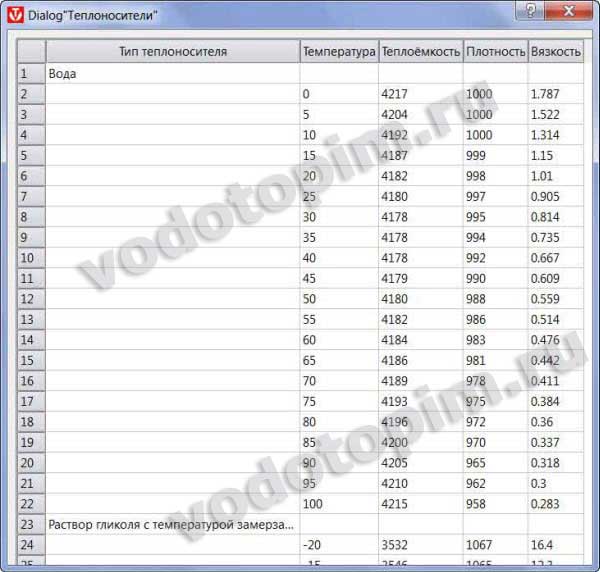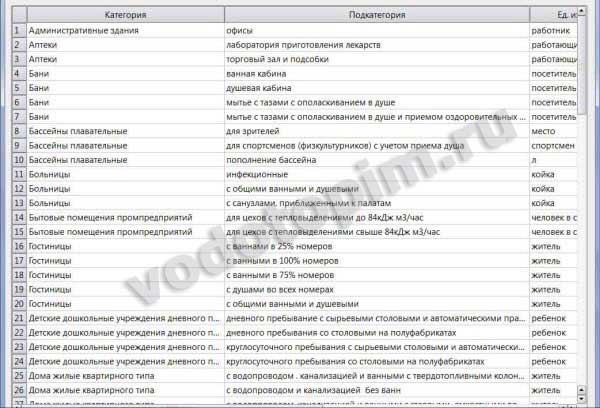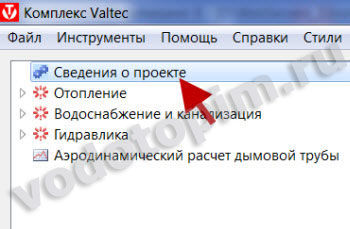Program for calculating the hydraulic resistance of the heating system. How to make a hydraulic calculation of the heating system. Heating system hydraulics example
Calculations of hydraulic and thermal parameters of engineering systems is a very responsible job. Any of the mistakes made during its implementation can result in the inability of the equipment to provide comfortable use and the need for a major redesign of the system. At the same time, the times of mass application of standard projects are in the past, and the designer has to deal with solving a unique problem every time. VALTEC specialists develop tools to avoid time-consuming manual calculations of engineering systems or make them as easy as possible.
Once the file has been downloaded, it must be run to install the application. general description software. This software also allows the user to create piping in chilled water systems. The design of the central heating system must meet the following criteria.
Pumping system Piping designs: two-pipe arrangement, one-pipe arrangement, or mixed arrangement Heating or cooling media: water, ethylene glycol, propylene glycol. Feed system, down feed system, horizontally distributed pipe systems, manifold systems. Floor radiators. radiators Automatic air vent valves Conventional or thermostatic radiator valves Initial regulation with pre-installed valves or orifices Stabilization of differential pressure with damping stabilizers Possibility of using flow controllers. convection radiators. . Application catalog database includes information about pipes, plumbing fixtures and radiators produced by leading domestic and foreign companies.
VALTEC.PRG.3.1.3. Program for thermal and hydraulic calculations
The VALTEC.PRG program is in the public domain and makes it possible to calculate water radiator, floor and wall heating, determine the heat demand of the premises, the necessary costs of cold, hot water, the volume of sewage, get hydraulic calculations internal networks of heat and water supply of the facility. In addition, at the disposal of the user is a conveniently arranged selection of reference materials. Thanks to a clear interface, you can master the program without having the qualifications of a design engineer.
What is the essence of such a calculation?
Its high flexibility allows the user to simultaneously use pipes, plumbing fixtures and radiators from different companies in the same design. The application allows the user to make full hydraulic calculations of heating systems. As part of such calculations, it is software.
Many of the solutions used in the application make the work easier and more efficient. The most important of them are. Graphical processes for data entry and presentation of results in the developed form. Quick access to catalog data for pipes, radiators and plumbing fixtures. Data entered in graphical form in expanded form.
- Difference between version 3.1.3 and version 3.1.2:
- added a module for calculating the throughput of pipes;
- amendments were made to the module for calculating the need for water according to SNiP - it is possible to continue the calculation with a probability of more than one (insufficient number of devices);
- expanded reference table "Pipes";
- Updated "User Guide".
 VALTEC C.O. 3.8. Program for the design of heating systems
VALTEC C.O. 3.8. Program for the design of heating systems
Data is entered in graphical form on the designed view. The necessary information about the constituent components is entered in the tables associated with the developed representation. This allows the user to edit single pipes, radiators, plumbing fixtures and entire labeled groups.
Each entered component is associated with a system that checks its correctness and a help system that provides the user with information about the amount entered or with the corresponding catalog data. To streamline the input data, the software is equipped.
VALTEC C.O. is a calculation and graphic program for designing radiator and floor heating systems using VALTEC equipment, developed by the Polish company SANKOM Sp. z o.o. based on the latest version of Audytor C.O. – 3.8. The product allows you to design and regulate heating systems, make a full range of hydraulic and thermal calculations. The program is certified for compliance with the current building regulations of the Russian Federation and the requirements of the Voluntary Certification System of NP AVOK.
Tools in the Valtec Main Menu
Possibility of simultaneous editing of many system components Possibility to use ready-made blocks Intelligent functions duplicating any parts of the drawing horizontally and vertically, including renumbering rooms and sections Possibility to define an unlimited number of user’s own blocks consisting of any part of the drawing Quick access to auxiliary information about quantities to be entered, a system of pop-up buttons that optimizes access to the most frequently used components of the heating system, the function of dynamically linking data from the drawing with the data in the corresponding table, supporting the connection of pipes, plumbing and other components heating system. Editing data in tabular form allows you to individually adjust the parameters of many drawing components that are checked at the same time.
 VALTEC H 2 About 1.6. Program for the design of water supply systems
VALTEC H 2 About 1.6. Program for the design of water supply systems
VALTEC H 2 O is a program for designing cold and hot water supply systems using VALTEC plumbing, developed by the Polish company SANKOM Sp. z o.o. based on the calculation and graphic program Audytor H 2 O 1.6. Allows you to perform a complete calculation and design of a hydraulically balanced water supply system. The program complies with the requirements of the NP ABOK Voluntary Certification System and SNiP 2.04.01-85* “Internal Water Supply and Sewerage of Buildings”.
The dynamic link between the drawing and the data table makes the edited component stand out when expanded. An example of data duplication at the following levels. Supplied with the software, a library of standard drawing parts such as risers, apartment layouts and collections allows the user to quickly create a detailed view. Such blocks can be used in sequential designs. With a function that duplicates any part of the drawing, perhaps, for example. enter part of the developed system for the entire floor, and then automatically generate expanded views and data for the following floors.
 VHM-T Service. Program for work with heat meters VALTEC
VHM-T Service. Program for work with heat meters VALTEC
- reading current readings and characteristics of the meter;
- work with daily, monthly and annual archives;
- formation of statements of accounting for the consumption of thermal energy;
- date, time and automatic changeover to summer/winter time (if necessary);
- meter settings for operation in automated data accounting systems.
The VHM-T Service program is designed to work with VALTEC VHM-T heat meters in terms of:
Work computer software requirements
The new software versions are extended with a floor radiator design module. The module is an integral part of the graphic design system for central heating systems. The first step in designing a floor radiator is to determine the floor structure on which the heating coil is located. You can create a whole catalog of the most commonly used structures that can be used in successive projects.
The heat output of a floor radiator can be initially calculated immediately after determining its structure. This allows the user to estimate the approximate heat output of the radiator, the temperature of the floor surface and other parameters. The results obtained can be very useful when designing radiators for specific rooms.
- operating system Windows XP Service Pack 3 (32/64 bit) or higher;
- Visual C++ Redistributable Packages for Visual Studio 2013 (free download available from microsoft.com). As a rule, these packages are already present in versions of Windows 7 and higher with the latest updates.
The interaction of the working computer with the heat meter is carried out through an optoelectronic sensor with the appropriate drivers installed in the system.
Initial calculations of the heat output of the floor radiator. When adding floor radiators to the developed system design, it is enough to provide information about the type of radiator, its power and the floor area intended for the radiator. During the calculations, the software itself will assume the appropriate distance between the heating coils, determine the actual radiator area and the length of the heating coil.
With such solutions, the design of central heating systems with floor radiators should not cause any serious problems for the user. In addition, the software is equipped with a detailed system for checking radiators for correct design.
Setting up communication between the program and the meter
- Connect the optoelectronic sensor to the computer.
- On the front panel of the heat meter, hold down the button and hold (about 8 seconds) until the “=” symbol appears in the lower right corner of the screen.
- Bring the optoelectronic sensor to the meter's opto-receiver on the front panel.
- Give a command to establish a connection in the program.
 K200M controller control and settings emulator
K200M controller control and settings emulator
Heating system hydraulics example
System-designed view with optional floor radiator. Floor plan with added radiators. To this end, you must draw up a floor plan, and then mark radiators, pipes, and other system components on it. When the calculations are completed, the software will provide the dimensions of the radiator and draw them in the appropriate scale, provide the pipe diameter and valve settings. In the case of simple forms, the software also uses the heating coils of the floor radiators. This allows close cooperation between the architect and the heating system designer and contributes to a significant reduction in the design process.
Training program for users and servicemen of the upgraded K200M weather-dependent controller. The interface of the device is reproduced with the ability to set operating parameters and display prompts. Additional reference information: connection diagram, error codes, connection examples.
Checking data and calculation results. As data is entered, data health checks are performed by the software on an ongoing basis. This greatly reduces the number of errors. During the calculation, a complete check of the correctness of the data is performed.
As a result of checking the data and results, a list of identified errors is created. The list contains information about the type of error and its location. Extensive error diagnostics allow the designer to fully assess the quality of the design. The application is equipped with a mechanism for quickly finding the location of the error.
 Emulator of control and settings of the K200 controller
Emulator of control and settings of the K200 controller
VALTEC New Widget
You can install this widget on your site - on any page, in any place convenient for visitors. This will allow customers to be informed as quickly as possible about the appearance of new VALTEC products, with the provision of the necessary technical information. The "News" section is replenished automatically, simultaneously with the appearance of the product in the company's online catalog. A bonus for users is the ability to review previously proposed innovations.
The calculation results are presented both in tabular and graphic form. The format of individual system component labels can be freely changed. Results of calculations in tabular and graphical forms. In addition, the contents of all tables can be formatted and sorted according to any key.
Calculation results can be printed or printed. The user can select the scale of the drawing and use the drawing preview to see how the designed view will appear on paper. If the drawing does not fit on one sheet, the application draws an expanded representation in successive parts that can be glued together into a single image.
Embed code:
>> Program for calculating the heating system
To calculate the parameters required when designing a home heating system, there are special programs, calculators, including on-line. I prefer the program for calculating the Valtec heating system. She has everything the right tools to determine the heat loss of the house and the hydraulic resistance of the system.
The print preview option allows the user to preview pages before they are printed on paper. The current version of the software contains the catalog data of the following companies. Software catalogs are gradually supplemented. Companies and individual users of the software should send us the catalog data on the devices you would like to find in successive versions of the software.
Allows selection of thermostatic valves in circulation systems. The program allows you to perform complete hydraulic calculations for the system within which it is. Evaluates the hydraulic resistance of the individual components of the system, together with the required one-time pressure. Performs water flow control in the hot water circulation system by selecting suitable control components, calculates the required water circulation in the hot water system using the thermal method. selects three-way mixing valves for domestic hot water system, selects thermal insulation for pipes.
- Evaluates the calculation of water flow in pipes.
- Selects pipe diameters.
- Selects pressure regulators.
- Ability to design multiple systems in one project.
- Unlimited installation size. fast calculation process.
- Building underlays in the most popular vector and raster formats.
Before starting the calculation of the heating system, let's get acquainted with the capabilities of the Valtec program.
Unzip the downloaded archive with the program. You will have a folder in which you need to go and run the program by double-clicking on the icon:
1. Program icon for calculating the heating system.
The working window of the program will immediately open, since the program does not require installation:
Image, individual data range, pipe bonding coherence in the system, location of accessories. Checking the correctness of the calculation results includes, among other things. Agent gas flow rate, water pressure in front of the receivers, lack of voltage in the circuits caused by a general lack or insufficiency of control accessories in the circulation circuits, pipe insulation, water cooling in pipes. A list of detected errors is created as a result of checking the correctness of the results of data and calculations, which lists the types of errors and their locations.

2. Program window for calculating the heating system.
So, what can be done in the Valtec program?
Tools in the Valtec Main Menu
Valtec, like any other program, has a main menu at the top.
We click on the "File" button and in the submenu that opens we see the standard tools known to any computer user from other programs: 
The program is equipped with a mechanism for quick error detection. The calculation results are presented both in graphical and tabular form. The image layer format and the label format for individual system components can be freely changed. The calculation results can also be presented in the form of a system plan.
The contents of all tables can be formatted and sorted according to the selected filter. The print preview feature allows you to preview pages before printing. The program uses many solutions that simplify the work.

The "Calculator" program, built into Windows, is launched - to perform calculations:

With the help of the "Converter" we will convert one unit of measure to another:

There are three columns here:

In the far left, we select the physical quantity with which we work, for example, pressure. In the middle column - the unit from which you want to convert (for example, Pascals - Pa), and in the right - to which you want to convert (for example, into technical atmospheres). There are two lines in the upper left corner of the calculator, we will drive in the value obtained during the calculations into the upper one, and the conversion to the required units of measurement will be immediately displayed in the lower one ... But we will talk about all this in due time, when it comes to practice.
In the meantime, we continue to get acquainted with the "Tools" menu. Form Generator: 
This is necessary for designers who carry out projects to order. If we do heating only in our house, then we don’t need the Form Generator.
The next button in the main menu of the Valtec program is "Styles": 
She's in control appearance program windows - adjusts to the software that is installed on your computer. For me, this is such an unnecessary gadget, because I am one of those for whom the main thing is not “checkers”, but to get there. And you decide for yourself.
Let's take a closer look at the tools under this button.
In "Climatology" we select the construction area: 
Heat loss in the house depends not only on the materials of the walls and other structures, but also on the climate of the area where the building is located. Consequently, the requirements for the heating system depend on the climate.
In the left column we find the area in which we live (republic, region, region, city). If our settlement is not here, then choose the nearest one.
"Materials". Here are the options for different building materials used in the construction of houses. That is why, when collecting initial data (see previous design materials), we listed the materials of walls, floors, ceilings: 
Hole tool. Here is the information on door and window openings:

"Pipes". Here is collected information about the parameters of pipes used in heating systems: internal and external dimensions, resistance coefficients, roughness of internal surfaces:

We will need this in hydraulic calculations - to determine the power of the circulation pump.
"Heaters". Actually, there is nothing here except the characteristics of those coolants that can be poured into the heating system of the house: 
These characteristics are heat capacity, density, viscosity.
Water is not always used as a coolant, it happens that antifreezes are poured into the system, which are called "non-freezing" in the common people. We will talk about the choice of coolant in a separate article.
"Consumers" for calculating the heating system are not needed, because this tool for calculating water supply systems: 
"KMS" (coefficients of local resistance):

Any heating device (radiator, valve, thermostat, etc.) creates resistance to the movement of the coolant, and these resistances must be taken into account in order to correctly select the power of the circulation pump.
"Devices according to DIN". This, like "Consumers", is more about water supply systems: 
The working window of the Valtec program
Consider now the main window of the Valtec program. Left column first:

Select the line "Project information" and in the right part of the window indicate "Construction area":

If your locality is not on the list, choose the nearest one.
In the lines below, you can fill in the first two: “Project number” - 1, “Object name” - a residential building. However, you can leave it blank: this is more necessary for those who design to order.
We return to the left side of the program window; the second line from the top is “Heating”, it has several sub-items: “Heated floors”, “Warm walls”, “Heating of sites”, “Calculation of heat losses”, “Heaters”. Now we need only "Calculation of heat losses". You need to double-click on this title, after which the right part of the window will change: 
Heat losses are calculated in three steps, so there are three tabs here. In the first tab - "Calculation of heat loss. Stage 1" - the lines under the heading "Design parameters for the selected construction area" will be automatically filled.
What to do with the "Modes" field, I will tell and show in the following materials, including on the video, when calculating the heat loss of a particular house.
In the left column of the program window, you will need the “Hydraulics” items:  , calculation of heat losses at home video , calculate heating power
, calculation of heat losses at home video , calculate heating power
2013-2017 Copyright © The use of site materials is permitted with reference to



